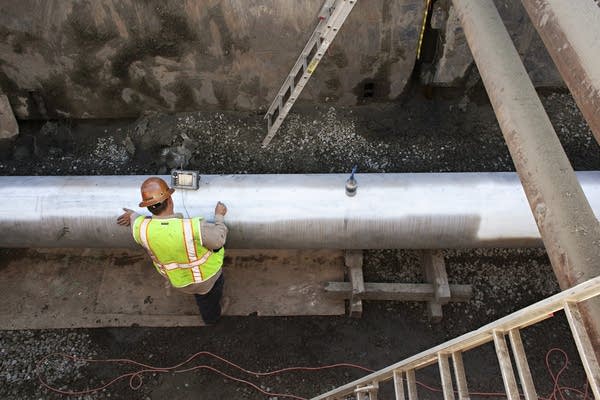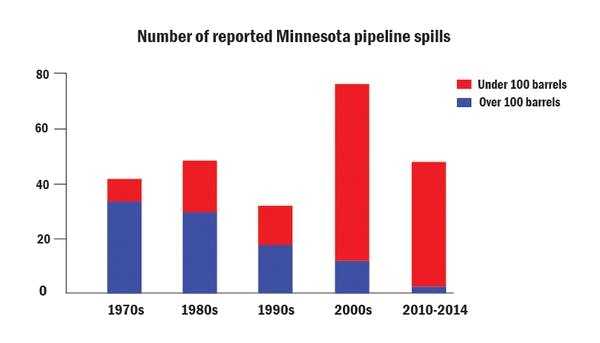Oil boom, pipeline safety put Enbridge on the spot

Go Deeper.
Create an account or log in to save stories.
Like this?
Thanks for liking this story! We have added it to a list of your favorite stories.
Plans for a new oil pipeline across northern Minnesota are bringing increased scrutiny to Enbridge, the company that wants to build it.
The Canadian-based company has more than 1,800 miles of pipeline in the state. It wants to build more than 600 miles more across North Dakota and northern Minnesota to deliver light crude from North Dakota's Bakken oil fields to eastern refineries.
The project, known as the Sandpiper pipeline, was dealt a setback recently when the Minnesota Public Utilities Commission called for a more thorough study of alternative routes. Deeper concerns about safety linger among farmers and environmentalists in Sandpiper's projected path.
That's put the spotlight on Enbridge and its record. Federal data show 49 spills since 2002 on Enbridge lines in Minnesota. Most were considered minor spills, though in 2002, an Enbridge line ruptured near Cohasset, Minnesota, a few miles from Grand Rapids, spilling more than 250,000 gallons of crude oil.
Turn Up Your Support
MPR News helps you turn down the noise and build shared understanding. Turn up your support for this public resource and keep trusted journalism accessible to all.
• September: Enbridge delays pipeline for at least a year
• August: State agencies, citizens ask for alternatives to route
The company says it's learned from the spills and that's resulted in significant safety improvements. When a pipeline inspection gauge near the Cohasset site found a crack recently, the company responded with a crew and a plan.
"That's why we came out here. We verified that the crack was there and determined that it needed a sleeve," Nathan Horyza, repair manager on six Enbridge pipelines between Bemidji, Minnesota and Superior, Wisconsin, said on a recent day as a crew worked at the bottom of a hole 10 feet deep where a stretch of crude oil pipeline about 40 feet long sat exposed.

They welded a metal sleeve over the crack in the 34-inch wide pipe and then waved a device similar to a doctor's office ultrasound wand over the weld to check for flaws.
Horyza will oversee about 150 digs during the year. Those usually result in repairs to a pipe, but technicians also collect data to verify the accuracy of the inspection gauges.
The company has increased its inspection schedule, checking all of its pipelines in Minnesota since 2011, and it's starting to re-inspect those lines to compare the findings said Enbridge spokeswoman Becky Haase.
Enbridge says it spent $60,000 per mile and completed 780 internal inspections across its U.S. hazardous liquid pipeline system between 2010 and 2014, a significantly larger investment than the $9,000 per mile and 350 internal inspections between 2005 and 2009.
Enbridge began changing its maintenance systems after a massive crude oil spill in Michigan in 2010 when more than 20,000 barrels of oil spilled, contaminating 38 miles of the Kalamazoo River.

The Pipeline and Hazardous Materials Safety Administration concluded Enbridge had known about cracks in the pipe for well over a year but took no action. Federal rules say a company must act on its pipeline inspection within six months. Federal officials also found alarm systems alerted Enbridge operators to the problem within seconds of rupture, but it was 17 hours before the line was shut down to stop the spill.
Nationwide only 43 percent of hazardous liquid pipelines are subject to inspection rules, according to the Pipeline Safety Trust, a watchdog group. While there have been some improvements the past decade, a recent increase in major incidents on hazardous liquid pipelines "is concerning," the trust said in a statement.

The Michigan accident and another major spill in Wisconsin in 2012 prompted significant safety improvements, said Walter Kresic, the company's vice president of pipeline integrity.
"We had to take a step back and look at why those incidents occurred and we did see that there were improvements that needed to be made," he said.
The company responded partly because federal regulators required it, he acknowledged, but said the primary reason for change was public perception and its contribution to the company's bottom line. "It's not good for business for us to be unsafe or to be perceived to be unsafe."
Enbridge added more inspections and changed the criteria for when it digs up pipe to check a potential flaw, he said. A revised maintenance schedule means more pipe will be replaced instead of repaired. The company is spending more money on research to develop better inspection and leak detection tools.
Kresic expects the annual maintenance spending to taper off in the next few years as the system conforms to new standards. He insists the major spills of recent years changed the Enbridge culture in a way that will have a lasting effect on pipeline safety.
Dear reader,
Your voice matters. And we want to hear it.
Will you help shape the future of Minnesota Public Radio by taking our short Listener Survey?
It only takes a few minutes, and your input helps us serve you better—whether it’s news, culture, or the conversations that matter most to Minnesotans.






